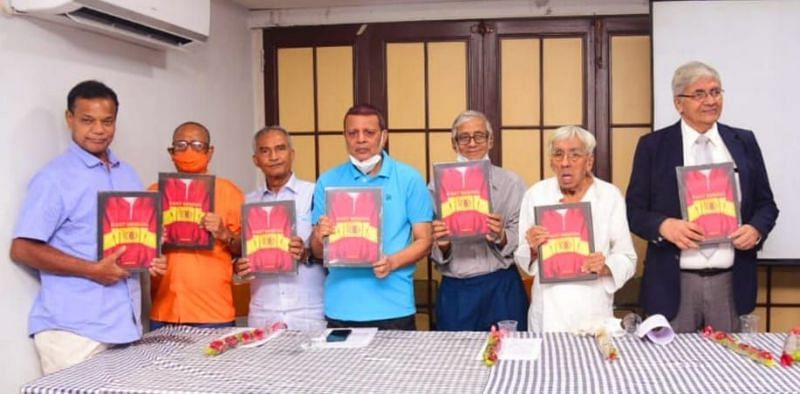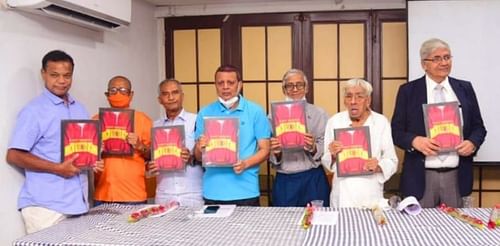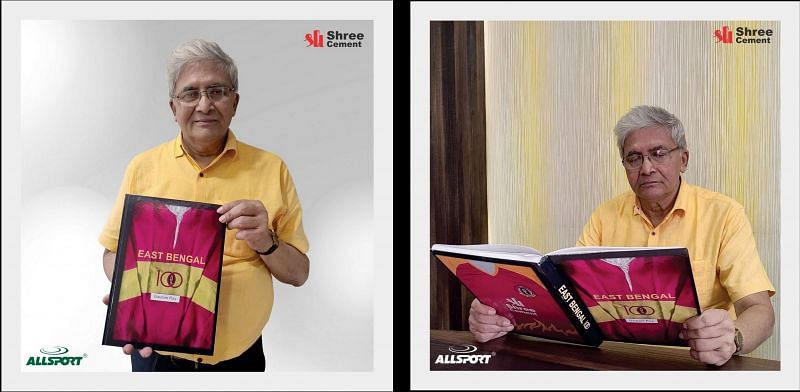
“My book East Bengal 100 celebrates the club’s rich heritage and its fans”: Gautam Roy

During his visit to India in 2006, former FIFA President Sepp Blatter had described India as the “sleeping giant” of world football. One and a half decades have elapsed since then, but the “giant” refuses to wake up from its deep slumber.
Once hailed as the “Brazil of Asia”, India’s performances at the international level have dipped so low that they now struggle to defeat relatively weaker sides like Nepal, Bangladesh and Afghanistan.
Poor infrastructure and the myopic vision of Indian Football’s apex body continue to impede the national team’s progress. Despite these maladies, the prime reason why Indian Football hasn’t lost its relevance is because it boasts of one of the most riveting derbies in the world.
The epic rivalry between the two Kolkata giants, East Bengal and Mohun Bagan, has sustained the country’s football system for nearly a hundred years now, and must do so for many years to come if Indian Football has to be saved from declining even further.
Nicknamed “Red and Golds” and “The Torchbearers”, East Bengal came into existence on 1 August 1920, when Kolkata Maidan was the fiefdom of British teams.
Unlike Mohun Bagan, which had already captured the imagination of the natives by beating East Yorkshire Regiment 2-1 in the 1911 IFA Shield final, East Bengal, being a newcomer, had to gradually work its way up the pecking order. Its first challenge was to resist the prevalent colonial hegemony on the football pitch and prove its mettle.
Known for its aggressive approach from the outset, East Bengal won its maiden Calcutta Football League and IFA Shield titles by 1943, and with the influx of a large refugee population post India’s partition, the club’s support base grew manifold. For these immigrants, the club became a natural symbol of their struggles in a new milieu fraught with various difficulties.
Today, East Bengal stands as one of the greatest clubs in Indian Football history with 39 CFL, 10 Rovers Cup, 16 Durand Cup, 29 IFA Shield, 8 Federation Cup and 3 National Football League titles to its name. It is also the only Indian club to win 3 international trophies – the Wai Wai Cup, the ASEAN Cup and the San Miguel International Cup.
Last year, East Bengal celebrated its centenary and added a new leaf to its annals by entering the Indian Super League, the country’s current top-tier competition. Noted football historian and statistician Gautam Roy has documented the Red and Golds’ illustrious 100-year journey in his book, “East Bengal 100”.
Published by Allsport Foundation and presented by the club’s current investor Shree Cement Limited, the 232-page book was launched at Kolkata’s International Club on 9 October, in the presence of club legends Sukumar Samajpati, Manoranjan Bhattacharya, Gautam Sarkar, Swapan Sengupta and Samaresh Chowdhury.
Sportskeeda’s Ritam Basu caught up with the author shortly after the event. Excerpts:-

Q: "East Bengal 100", as you say, is the most comprehensive documentation of East Bengal’s century-old history. How extensive was the research?
Roy: Well, it was very extensive. I was the Media Manager of East Bengal Club between 2011 and 2019. I embarked on this project independently when the club was approaching its centenary. It took me four years to write the book. I was also the Associate Editor of the East Bengal Almanac and noticed that there were gaps in knowledge of people living outside Kolkata about East Bengal’s rich heritage, culture and legacy. It was the prime reason why I decided to write the book.
Q: What sources did you consult in the process?
Roy: I mainly consulted Paresh Nandy’s “East Bengal Club, 1920–1970: Ponchas Bochhorer Sangram o Safalya” and some old newspapers kept by the National Library and the Statesman Library. I also interviewed many former East Bengal players who furnished me with some intriguing anecdotes. The main theme of the book, however, is how East Bengal Club gave an identity to immigrants from the erstwhile eastern Bengal (now Bangladesh) post India’s partition, and inspired them to settle in the mainstream.
Q: Could you give us an overview of the book?
Roy: My book covers the entire history of the club, starting from its inception in 1920 to its entry into the ISL last year. I’ve gone decadewise and explored:-
- The prevalent social conditions of Kolkata maidan in the early 20th century
- How East Bengal got its red-and-gold colours and torch emblem
- How the club broke the unfair law of the IFA to get promoted and play in the first-division
- The 30s in which the "barefooted" East Bengal fell short of the Calcutta Football League title four times by just one point
- The glorious 40s and 50s when the iconic ‘Pancha Pandavas’ powered the club to numerous titles
- East Bengal’s tour of the USSR in 1953
- The emergence and dominance of Tulsidas Balaram, Ram Bahadur and Arun Ghosh in the 50s leading up to the 60s
- The 60s dominated by players like Prasanta Sinha and Parimal Dey
- The celebrated 70s in which East Bengal won the CFL six times in a row, defeated Iran’s PAS Club, and recorded the highest victory margin against Mohun Bagan (5-0 in the 1975 IFA Shield final)
- The arrival of Majid Bishkar, Jamshid Nassiri and Krishanu Dey in the 80s
- The rise of Bhaichung Bhutia in the 90s and his hat-trick in the 1997 IFA Shield semi-final
- The historic ASEAN Cup win under coach Subhash Bhowmick in 2003
- The early 2010s in which East Bengal won eight consecutive CFL titles (2010-17), came close to winning the I-League on multiple occasions and became the first Indian club to reach the AFC Cup semi-finals undefeated (2013).
Besides, the book contains several rare photos, lesser-known stories about the Kolkata derby, fans’ perspectives and, most importantly, the results of all the matches played by East Bengal so far (7000+ matches).
Q: In Kolkata Maidan, the club officials have traditionally been very influential. Does your book throw light on their contributions too?
Roy: Yes, certainly! I think the founders of the club were excellent. I’ve narrated how the likes of Suresh Chandra Chaudhuri, Tarit Bhushan Roy, Banoarilal Roy and the Maharaja of Santosh laid the club’s foundation and countered the elite rule of the times by putting their resources together. I’ve also talked a good deal about Nalini Ranjan Sarkar (who became the Finance Minister of West Bengal in 1948), Jyotish Chandra Guha, Dr Nripen Das, Montu Bose, Ajay Sreemani, Paltu Das and Swapan Bal, and how their administrative finesse took the club to its zenith.
Q: Why do you think so little work has been done to chronicle the histories of Indian football clubs?
Roy: You’ve raised a good question. More writings on Indian Football should’ve been published because I feel football is still the second most popular sport in the country, after cricket.
It’s true that our current FIFA ranking is poor, but don’t forget that the Indian team was called the Brazil of Asia in the 50s and 60s. Even to this day, football continues to be the primary sport in West Bengal, Kerala, Goa and the Northeast. I wish there were more books covering India’s rich football heritage.
In Goa, a very energetic and enterprising reporter named Margus Mergulhao wrote two wonderful books to commemorate the Golden Jubilee of Dempo Sports Club and the Diamond Jubilee of Salgaocar FC.
However, there are only a few significant works covering the history of Indian Football in English, namely the ones penned by Novy Kapadia and Jaydeep Basu.
Q: You’ve been a close observer of Indian Football for the past four decades. Are you currently working on any book on Indian Football?
Roy: Yes, I’m currently working on one. The pandemic has restricted my research work, but I shall resume the project as soon as everything returns to normal. Hopefully the book will come out in another couple of years’ time.
Q: Let’s play a short rapid fire round.
East Bengal’s most memorable win – 1-0 vs Iran’s PAS Club, 1970
P.K. Banerjee or Subhash Bhowmick – who was a better coach? – P.K. Banerjee
East Bengal’s all-time best goalkeeper – Peter Thangaraj
East Bengal’s all-time best forward – Tulsidas Balaram
East Bengal’s all-time best foreigner – Majid Bishkar
One result of East Bengal that you would like to delete from your memory – East Bengal’s 1-6 loss to Central Police Lines Hyderabad, 1961 Rovers Cup
The most underrated East Bengal player – Prasanta Sinha and Balaram. Sinha should’ve played more for India and Balaram should’ve received the Padma Shri.
Q: The final question. Why do you think every East Bengal fan and Indian Football lover should buy "East Bengal 100"?
Roy: They should buy the book because it contains a plethora of stories and the history of one of Asia’s biggest clubs. There have been a lot of football clubs that started well, but later faded out. East Bengal is a club that was born in a dramatic manner and has lasted 100 years. East Bengal’s contribution to Indian football has been immense. I dedicate this book to the fans.